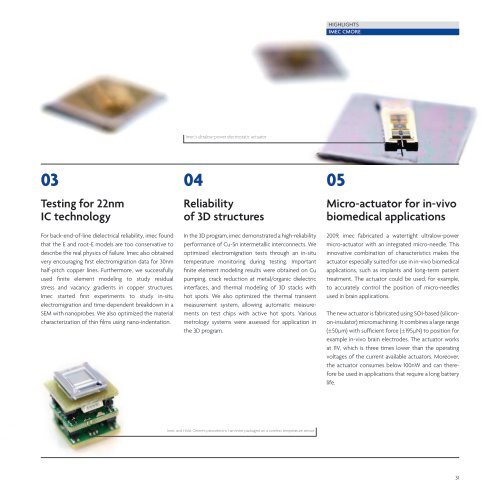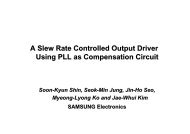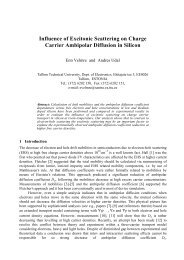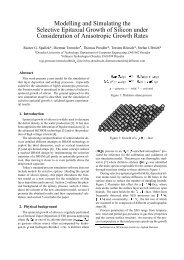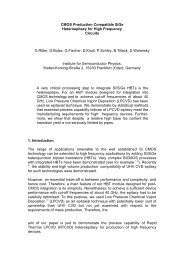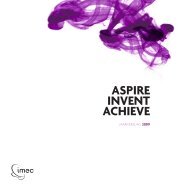Annual report 2009 - Imec
Annual report 2009 - Imec
Annual report 2009 - Imec
Create successful ePaper yourself
Turn your PDF publications into a flip-book with our unique Google optimized e-Paper software.
03<br />
Testing for 22nm<br />
IC technology<br />
For back-end-of-line dielectrical reliability, imec found<br />
that the E and root-E models are too conservative to<br />
describe the real physics of failure. <strong>Imec</strong> also obtained<br />
very encouraging first electromigration data for 30nm<br />
half-pitch copper lines. Furthermore, we successfully<br />
used finite element modeling to study residual<br />
stress and vacancy gradients in copper structures.<br />
<strong>Imec</strong> started first experiments to study in-situ<br />
electromigration and time-dependent breakdown in a<br />
SEM with nanoprobes. We also optimized the material<br />
characterization of thin films using nano-indentation.<br />
<strong>Imec</strong>’s ultralow-power electrostatic actuator<br />
04<br />
Reliability<br />
of 3D structures<br />
In the 3D program, imec demonstrated a high-reliability<br />
performance of Cu-Sn intermetallic interconnects. We<br />
optimized electromigration tests through an in-situ<br />
temperature monitoring during testing. Important<br />
finite element modeling results were obtained on Cu<br />
pumping, crack reduction at metal/organic dielectric<br />
inter faces, and thermal modeling of 3D stacks with<br />
hot spots. We also optimized the thermal transient<br />
measurement system, allowing automatic measurements<br />
on test chips with active hot spots. Various<br />
metrology systems were assessed for application in<br />
the 3D program.<br />
<strong>Imec</strong> and Holst Centre’s piezoelectric harvester packaged on a wireless temperature sensor<br />
hIGhLIGhTs<br />
IMEC CMORE<br />
05<br />
Micro-actuator for in-vivo<br />
biomedical applications<br />
<strong>2009</strong>, imec fabricated a watertight ultralow-power<br />
micro-actuator with an integrated micro-needle. This<br />
innovative combination of characteristics makes the<br />
actuator especially suited for use in in-vivo biomedical<br />
applications, such as implants and long-term patient<br />
treatment. The actuator could be used, for example,<br />
to accurately control the position of micro-needles<br />
used in brain applications.<br />
The new actuator is fabricated using SOI-based (siliconon-insulator)<br />
micromachining. It combines a large range<br />
(±50µm) with sufficient force (±195µN) to position for<br />
example in-vivo brain electrodes. The actuator works<br />
at 11V, which is three times lower than the operating<br />
voltages of the current available actuators. Moreover,<br />
the actuator consumes below 100nW and can therefore<br />
be used in applications that require a long battery<br />
life.<br />
31


